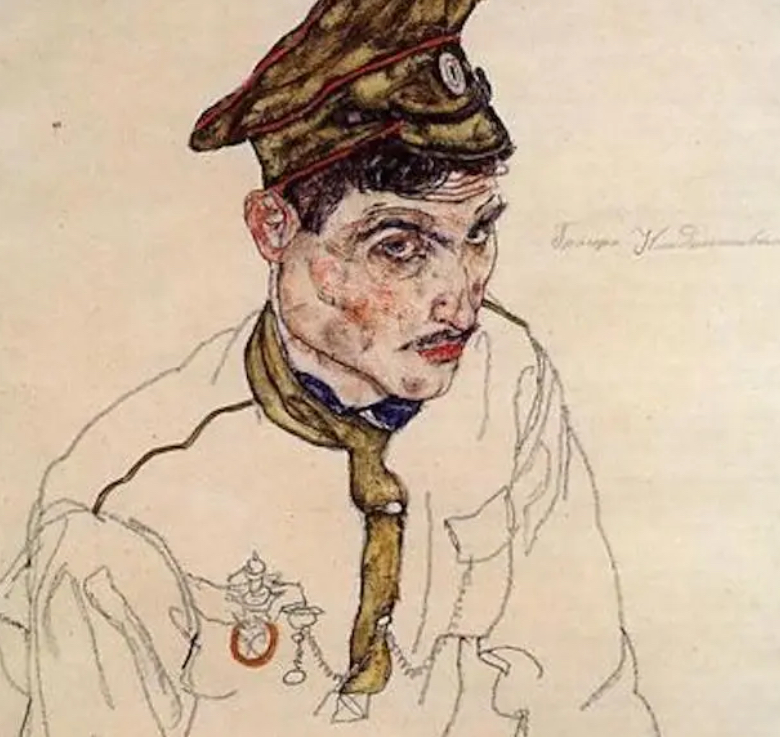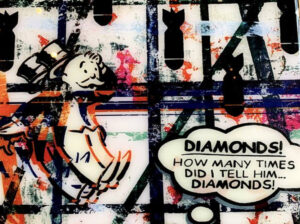In the pantheon of early twentieth-century European art, few figures are as emotionally raw or as visually distinctive as Egon Schiele. A protégé of Gustav Klimt and a critical member of the Viennese Secessionist movement, Schiele’s style cut through the decorative excess of Art Nouveau, favoring instead a visceral, unflinching exploration of the human condition. While his best-known works often feature stark nudes, distorted bodies, and introspective self-portraits, one of his most compelling and overlooked works is Russian War Prisoner (1916).
Painted during the height of World War I, this portrait captures not only a physical likeness but also the psychological toll of warfare and captivity. It stands as a testament to Schiele’s ability to confront the grim realities of his era while maintaining an empathetic gaze towards his subject.
The Context: Schiele During World War I
When war broke out in 1914, Egon Schiele was initially shielded from the frontlines. Due to his artistic skills and fragile health, he was assigned relatively light duties, often working as a clerk or performing administrative tasks. By 1915, however, he was conscripted more seriously, posted at a prisoner-of-war camp in Mühling, Lower Austria. There, Schiele found himself surrounded by captured soldiers from Russia and Italy — men who embodied the physical and emotional collapse of Europe.
Unlike many artists who turned to patriotic propaganda during wartime, Schiele saw in these prisoners not enemies, but individuals broken by forces beyond their control. His work from this period, including Russian War Prisoner, reflects an unusual sympathy, an intimate portrayal of suffering without glorification or hatred.
The Subject: Anonymous Humanity
The identity of the man depicted in Russian War Prisoner remains unknown. He is one of thousands who were swept up in the vast machinery of global conflict. Yet Schiele renders him with the intensity and care typically reserved for personal acquaintances or respected sitters.
The prisoner sits stiffly, wearing a tattered uniform. His hands — large, weathered, almost claw-like — are positioned awkwardly on his lap, suggesting discomfort, defensiveness, or resignation. His face, gaunt and roughened by hardship, is framed by unruly hair and a thick, patchy beard. The eyes are perhaps the most haunting feature: heavy-lidded, hollow, and distant, they seem to float somewhere between exhaustion and defiance.
Unlike academic portraiture, which often idealized or sanitized its subjects, Schiele’s Russian War Prisoner is brutally honest. There is no heroism here, no sanitized nobility — only the worn, battered humanity of a man caught in forces far beyond his control.
The Composition: Economy of Means, Depth of Feeling
Schiele’s stylistic trademarks are fully evident in Russian War Prisoner. The background is bare, almost clinical — a blank, unarticulated space that isolates the figure entirely. There is no setting, no props to contextualize the man’s existence. The focus is absolute.
The figure itself is drawn with an economy of line that belies its emotional weight. Schiele’s signature angularity is present, with sharp outlines defining the figure’s contour. His use of color is muted but strategic: earthy browns, olive greens, sickly yellows. The palette mirrors the drabness of military uniforms and the lifeless environment of a POW camp.
The brushwork is rough, almost impatient at times, but deliberate. Every line, every wash of color, every blank space contributes to the sense of vulnerability and psychic exposure. The man appears simultaneously grounded — his heavy body anchoring him to the earth — and precarious, as if he might dissolve into the surrounding void at any moment.
Psychological Depth: Beyond Portraiture
In Russian War Prisoner, Schiele isn’t merely documenting an individual; he’s capturing a state of existence. The psychological nuances embedded in the figure’s posture, expression, and aura are profound.
The prisoner’s hands — disproportionately large and gnarled — become a focal point. They suggest both the manual labor forced upon prisoners and the lingering capacity for action, however futile. The man’s eyes, sunken and almost lifeless, reveal an internal world drained by trauma. His slightly tilted head implies wariness, as if expecting another blow, another indignity.
Schiele taps into something archetypal here: the image of the defeated but unbroken man. The figure is an everyman, a stand-in for all the nameless casualties of industrialized warfare. In stripping away individuality, paradoxically, Schiele universalizes the subject’s experience.
War and Empathy in Schiele’s Work
It’s important to recognize how radical this portrait was in its time. The war had unleashed a torrent of propaganda images that dehumanized the enemy — Russian soldiers were often depicted as barbaric, primitive, or faceless hordes threatening European civilization.
Schiele, by contrast, presents his Russian prisoner with an unflinching empathy. There is no caricature, no demonization. The figure is not a villain; he is a victim, much like Schiele himself and much like the broader populace trapped in a war few truly understood or wanted.
This humanistic stance was consistent with Schiele’s broader artistic philosophy. Throughout his career, he resisted moralistic or nationalistic narratives. Whether depicting lovers, mothers, beggars, or prisoners, he sought to reveal the emotional and existential core of his subjects.
Artistic Evolution: Schiele’s Wartime Shift
Russian War Prisoner also marks a subtle evolution in Schiele’s style during the war years. Pre-war, his work had often leaned toward eroticism, psychological tension, and personal anguish. The bodies he drew were often contorted, hypersexualized, or rendered in states of existential crisis.
During the war, Schiele’s focus turned outward. The suffering he portrayed became more collective, more grounded in social reality. His lines remained sharp, his colors remained spare, but the content grew heavier, less self-referential.
Russian War Prisoner stands at the crossroads of this shift. It retains the technical hallmarks of his earlier work — the skeletal modeling, the harsh contours — but applies them to an external, communal tragedy rather than personal neurosis.
Reception and Legacy
Schiele’s wartime portraits, including Russian War Prisoner, were largely overlooked during his lifetime. His death from the Spanish Flu in 1918 at the age of 28, just days after his pregnant wife Edith passed, cut short what might have been a towering career.
Only later, as twentieth-century audiences grappled with the full horrors of industrial warfare, did Schiele’s wartime works gain their due recognition. Today, Russian War Prisoner is seen not merely as a portrait of a man but as a meditation on the vulnerability of all human life during times of systemic violence.
Art historians now view the piece as a precursor to the existentialist themes that would dominate postwar European thought and culture. The isolation, despair, and alienation visible in Schiele’s prisoner would echo in later works by writers like Jean-Paul Sartre and artists like Francis Bacon.
Schiele’s Enduring Relevance
Russian War Prisoner is not an easy painting. It does not flatter its subject, nor does it offer easy catharsis for its viewer. It demands that we confront suffering directly, without romanticization or aesthetic consolation.
In this sense, the work remains powerfully relevant. In an era still plagued by war, displacement, and dehumanization, Schiele’s portrait reminds us of the enduring dignity of the individual human being — even when stripped of freedom, safety, and identity.
Egon Schiele captured a moment in time — a face, a body, a spirit battered but not broken — and, in doing so, created a work that transcends its historical moment. Russian War Prisoner stands as a raw, unblinking testament to the resilience of the human soul amidst the ruins of human cruelty.
No comments yet.









